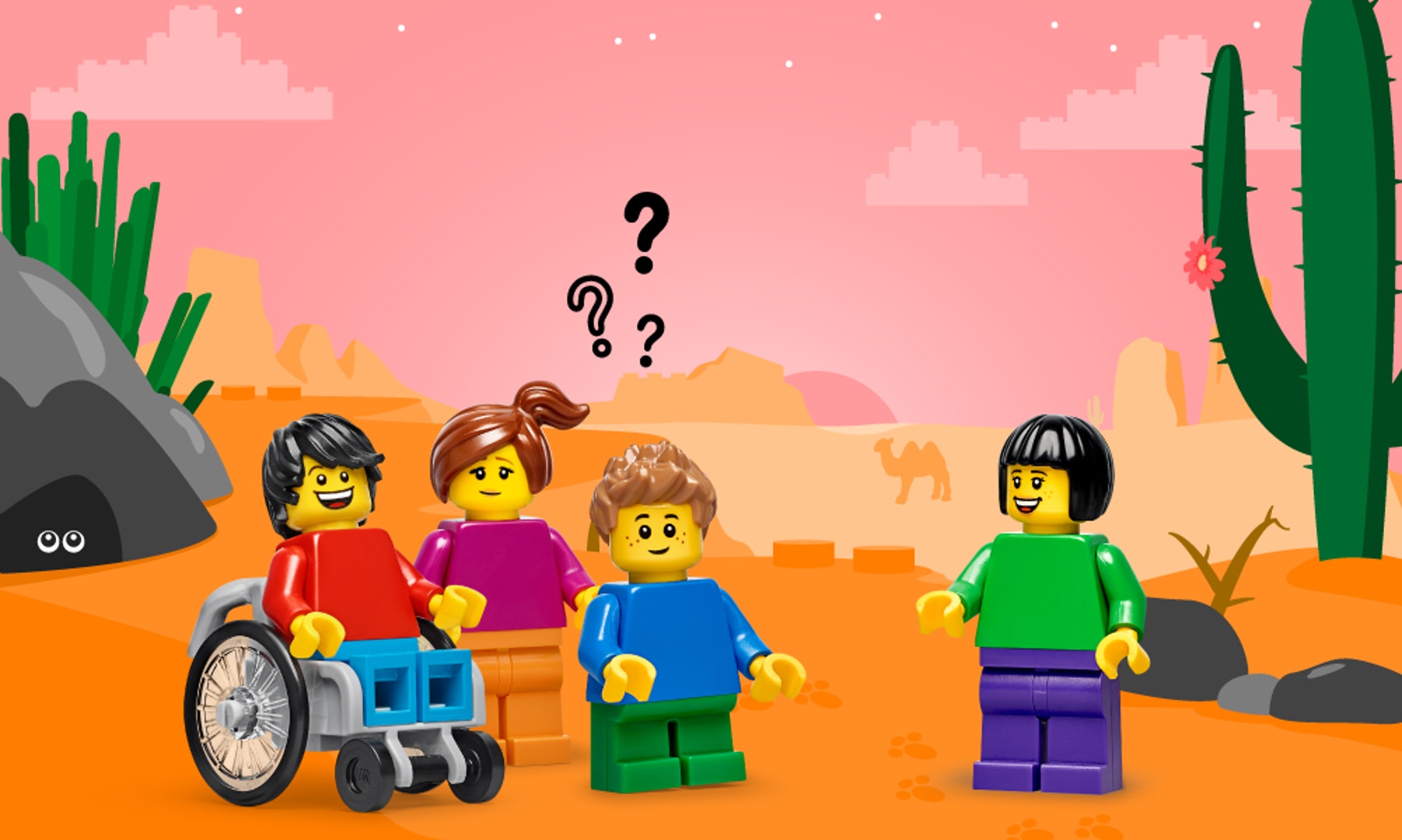Animals in Their Habitats
Sofie, Daniel, Maria, and Leo visit a desert. They wonder how the animals and plants survive where it is so dry.

Prepare
(NOTE: This lesson contains a Part A and a Part B. Both are important to access the full learning of the standard. If time is limited, review both parts to choose elements that meet your students’ needs.)
In this lesson, the key learning is about constructing an argument about ways that habitats meet the needs of the plants and animals that live in them. Designing and building a model offers a fun, hands-on opportunity to understand a habitat and its occupants. Encourage students to build their ideas for a chosen habitat and the plants and animals that live in it. Reinforce that there is no single correct model.
Consider organizing groups of four or more students by combining pairs and then assigning a habitat or letting each group choose a familiar one. Pairs within the group will build different animals. Animals in a group should be relatively scaled, such that a fox is understood to be much bigger than a lizard.
- Science Background - Animals in Their Habitats:
- The desert habitat illustrated in this lesson is modeled on the Sonoran Desert of the southwestern United States.
- While all deserts are very dry environments, not all are extremely hot in the summer like the Sonoran.
- Some deserts, in Antarctica for example, are cold throughout the year.
- The United States has a wide range of other habitats, including wetlands, grasslands, forests, and tundra.
- Build Prior Knowledge - Animals in Their Habitats: Using your core science materials, share information, images, and definitions.
- A habitat is a wild place where an animal or a plant lives.
- Each kind of animal or plant is adapted to survive in a particular habitat. It usually cannot survive as well in a different habitat because its needs will not be met there.
- An argument supports a claim or statement about something that happens in nature (e.g., desert animals can survive many days without water). It should include evidence like reasons, data like facts, and/or a model demonstrating observations.
- Key vocabulary: habitat, survive, adapted, desert
- Building and Programming Experience: Review the suggestions in the Unit Plan. For this lesson, you may also want to
- Reinforce with the Motor tutorial in the SPIKE App Start menu.
- Use the Motor section of the Help>Word Blocks menu in the SPIKE app to provide more support.
- Materials: Locate age-appropriate resources and images about various North American habitats and the animals in them. Search online for North America habitats. Try websites of natural history museums, zoos, and atlases. If you wish, collect craft materials that students may use to enhance their habitat models.
PART A (45 minutes)
Engage
(Whole Class, 10 minutes)

Introduce the story’s main character(s) and the first challenge: Sofie, Daniel, Maria, and Leo visit a desert. They wonder how the animals and plants survive where it is so dry.
THINK—Facilitate a brief discussion about the lesson topic(s), using the located images and the story picture if you wish.
- What is a habitat? (A habitat is a wild place where an animal or a plant lives. It has the food, water, and shelter that a plant or an animal needs, as well as space for the animal to move. For example, shelter is a place to hide from predators, to stay cool or warm, or to raise the animal’s young.)
- What is a desert like? (All deserts are dry; some are hot all year and others are cold for part or all of the year.)
- How do desert animals and plants survive? (Possible answers: Some animals can live without water for long periods of time; cacti store water and have waxy coatings to prevent water loss. Some animals stay underground when it is too hot or cold. Others have light-colored fur that keeps them cooler.)
- What about other habitats? (Animals and plants are adapted to survive in their habitat.)
Choose the desert or another habitat. You’ll work in a group to show how animals and plants in that habitat are adapted to live there.
Distribute a SPIKE™ Essential Set and a device to each group.
Explore
(Small Groups, 25 minutes)
Review that students may design and build any model they wish in this open-project lesson. Reinforce that there is no single correct model.
Have students:
- Work in groups of four to plan the habitat they will show and choose the plants and animals they will build, including making sketches if desired.
- Work in pairs to BUILD a model of one animal that lives in the habitat they planned. Guide pairs to coordinate so that their models show different animals but all reflect similar scales.
- PROGRAM their animal model to use a motor to move in some way.
Facilitate brainstorming ways to use LEGO® elements and motors to make an animal that moves, such as by walking, waving its tail, opening and closing its mouth, etc.
Halfway through work time, have students exchange ideas using a familiar classroom routine and then update their models with inspiration from sharing.
Explain
(Whole Class, 10 minutes)
Gather students for sharing.
Have each group use their models and habitat designs to demonstrate and explain:
- What their habitat is like.
- What kind of animals they built for the habitat.
- What body parts (like light-colored fur) or behaviors (like coming out at night only) help the animal survive in that habitat.
Invite students to share how they changed their model to improve its performance.
Have students keep their partially completed model animals intact for use in Part B.
PART B (45 minutes)
Explain
(Whole Class, 5 minutes)
- Repeat the steps from Part A—Explain to have additional groups demonstrate and explain their learning.
Elaborate
(Whole Class, 30 minutes)
Have students:
- (15 min) Work in their Part A groups to build the habitat they designed (in Explore) for their animals. They may use craft materials in addition to LEGO® elements.
- (10 min) Briefly share their completed habitat with the class, making and supporting an argument for how and why the animals in it are adapted to live there. Support should include evidence, such as reasons.
(5 min) Invite students to share knowledge, ideas, or skills that
- Helped them complete the challenge.
- They learned while building.
Have students clean up the sets and work areas.
Evaluate
(Whole Class, 10 minutes)
- Ask guiding questions to elicit students’ thinking and their decisions while ideating, building, and programming.
Observation Checklist
Review the key objectives (Teacher Support box).
Share specific student responses and behaviors at different levels of mastery.
Use the checklist to observe students’ progress:
- The habitat model they build is appropriately scaled and suitable for their chosen animals.
- Their animal model has moving parts and shows how it’s adapted to the habitat.
- They use evidence from their model and habitat to make an argument about how their animal is adapted to survive there.
Self-Assessment
Have each student choose the brick that they feel best represents their performance。
- Blue brick: I think I can follow instructions to create a program.
- Yellow brick: I can follow instructions to create a program.
- Green brick: I can follow instructions to create a program, and I can help a friend do it too.
Peer-Feedback
In their small groups, have your students discuss their experiences working together.
Encourage them to use statements like these:
- I liked it when you…
- I’d like to hear more about how you…
Differentiation
Simplify this lesson by:
- Choosing one familiar habitat and having all teams build animals for it.
Increase the difficulty by: - Giving students the options of adapting their animal to survive in a different habitat built by another group or modeling plants as well as animals in the original habitat.
Extension
- Have students write a story in which their animal is transported to a different habitat and must deal with new surroundings for which it is not well adapted. Encourage them to make their story realistic by using details from research or their classmates’ habitat models.
If facilitated, this will extend beyond the 45-minute lesson.
Language Arts: CCSS.ELA-LITERACY.W.3.3
Teacher Support
Students will:
- Build a model of an animal with moving part(s) that is adapted to a particular habitat.
- Create a habitat model for their animal.
- Use their model as evidence to make an argument about how the animal is well adapted to survive in its habitat.
(one for every two students)
- LEGO® Education SPIKE™ Essential Set
- Device with the LEGO Education SPIKE App installed
- See Prepare - Materials.
Meet the team: Minifigure Bios
- NGSS 3-LS4-3: Construct an argument with evidence that in a particular habitat some organisms can survive well, some survive less well, and some cannot survive at all.
- NGSS 3-5-ETS1-1
- CSTA 1B-AP-15
- ISTE 1.4.c
- CCSS.ELA-LITERACY.SL.3.1
- CCSS.MATH.CONTENT.3.G.A.1
Language Arts Extension
- CCSS.ELA-LITERACY.W.3.3




